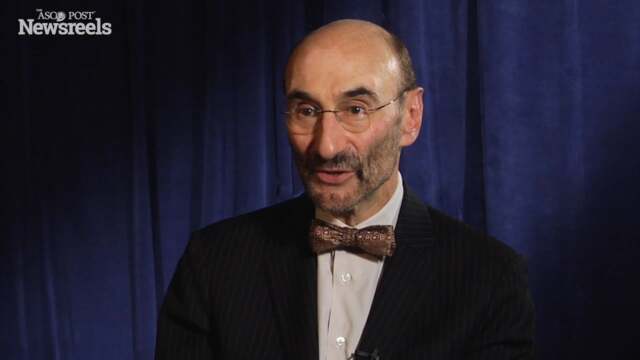FDA Grants Selumetinib Orphan Drug Designation for Adjuvant Treatment of Differentiated Thyroid Cancer
AstraZeneca announced on May 12 that the U.S. Food and Drug Administration (FDA) has granted Orphan Drug designation for the investigational MEK 1/2 inhibitor selumetinib (AZD6244, ARRY-142886) for adjuvant treatment of patients with stage III or IV differentiated thyroid cancer. Differentiated...
Overcoming Radiosensitization in Head and Neck Cancer
In a study reported in the Journal of the National Cancer Institute, Eke and colleagues found that simultaneous β1 and epidermal growth factor receptor (EGFR) inhibition resulted in increased cytotoxicity, radiosensitization, and tumor control in human head and neck squamous cell carcinomas....
Nivolumab: New Standard of Care for Progressive Head and Neck Cancer After Platinum Therapy
Squamous cell carcinoma of the head and neck that progresses after platinum-based therapy has a dismal prognosis, and there is no effective standard of care. No treatment has improved survival for this patient population, but that may be about to change. Nivolumab (Opdivo), an anti–PD-1 (programmed ...
Spectrin Gene Identified as a Biomarker in HPV-Negative Oral Cavity Squamous Cell Carcinoma
Researchers have identified a gene that may help to predict survival outcomes in patients with cancer of the mouth and tongue. Patients whose tumors express a gene called spectrin are 4.6 times more likely to die at any given time, according to a study by researchers at Loyola Medicine and Loyola...
FDA Grants Breakthrough Designation to Nivolumab in Squamous Cell Carcinoma of the Head and Neck
On April 25, 2016, the U.S. Food and Drug Administration (FDA) granted breakthrough therapy designation to the anti–programmed death 1 antibody nivolumab (Opdivo) for the treatment of patients with recurrent or metastatic squamous cell carcinoma of the head and neck that previously received...
PTK2/FAK as Driver of Radioresistance in HPV-Negative Head and Neck Squamous Cell Carcinoma
As reported in Clinical Cancer Research, Skinner and colleagues used proteomic profiling to identify PTK2/FAK as a driver of radioresistance in human papillomavirus (HPV)-negative head and neck squamous cell carcinoma. Using proteomic and transcriptomic analysis of targetable markers, the...
AACR 2016: Nivolumab Improved Survival for Patients With Head and Neck Squamous Cell Carcinoma
For the latest information on CheckMate-141, click here, here, or here. Treatment with the immunotherapeutic nivolumab (Opdivo) improved survival for patients with recurrent or metastatic head and neck squamous cell carcinoma that progressed after platinum-based chemotherapy compared with...
AACR 2016: LOXO-101 Shows Continued Promise in Patients Whose Tumors Had NTRK Gene Fusions
The investigational drug LOXO-101, which selectively targets a family of proteins called neurotrophic tyrosine kinase receptors (NTRKs), produced significant tumor regression in patients whose tumors had NTRK gene fusions, according to data from a phase I clinical trial presented by Hong et al at...
AACR 2016: RAF-Targeted Therapeutic BGB-283 Shows Early Promise Against Tumors With BRAF and RAS Mutations
The new investigational anticancer therapeutic BGB-283, which targets the RAF family of proteins, was safe, tolerable, and showed signs of clinical activity in patients who had a range of types of cancer with mutations in BRAF, KRAS, and NRAS, according to results from a phase I clinical trial...
FDA Accepts Supplemental Biologics License Application for Pembrolizumab in Recurrent or Metastatic Head and Neck Cancer, Grants Priority Review
Merck today announced that the U.S. Food and Drug Administration (FDA) has accepted for review the supplemental Biologics License Application (sBLA) for pembrolizumab (Keytruda), a monoclonal antibody and anti–programmed cell death 1 (PD-1) therapy, for the treatment of...
UK Trial Shows Similar Survival With PET-CT Surveillance vs Planned Neck Dissection in Advanced Head and Neck Cancer
In a UK noninferiority trial reported in The New England Journal of Medicine, Mehanna et al found that positron-emission tomography–computed tomography (PET-CT) surveillance was associated with similar survival vs planned neck dissection in patients with stage N2 or N3 squamous cell carcinoma ...
New American Cancer Society Guideline Addresses Long-Term Needs of Head and Neck Cancer Survivors
A new American Cancer Society guideline provides clinicians with recommendations on key areas of clinical follow-up care for survivors of head and neck cancer, a growing population numbering approximately 436,060 and accounting for 3% of all cancer survivors living in the United States. The...
Markedly Improved Toxicity Rates With Proton-Beam Reirradiation for Recurrent Head and Neck Cancer
Proton-beam radiation therapy may be an attractive option for reirradiation of recurrent head and neck cancer, with encouraging disease control and survival rates and improved toxicity rates compared to photon reirradiation, according to John Han-Chih Chang, MD. Most head and neck cancers present...
Late Toxicity Improved With Response-Adapted Volume De-escalation in Locally Advanced Head and Neck Cancer
Efforts to reduce the late toxicity associated with chemoradiotherapy for locally advanced head and neck squamous cell cancer have focused on radiation therapy dose de-escalation in select populations, according to James Melotek, MD, a radiation oncologist at the University of Chicago. “Patients...
Study Supports an Immune Effect of Chemoradiation in Head and Neck Cancer
Definitive radiation, with or without chemotherapy, induces a combination of immune-stimulating and inhibitory effects in patients with squamous cell carcinoma of the head and neck, according to research presented by Jonathan Schoenfeld, MD, MPhil, MPH, at the 2016 Multidisciplinary Head and Neck...
Mutational Profile May Impact Treatment Decisions for Smokers With Human Papillomavirus–Positive Oropharyngeal Cancer
Smokers whose oropharyngeal tumors are positive for the human papillomavirus (HPV) might need more aggressive treatment for their disease, according to research presented by Jose Zevallos, MD, at the 2016 Multidisciplinary Head and Neck Cancer Symposium in Scottsdale, Arizona.1 Over time,...
Retrospective Analysis Suggests Benefit of Adding Cetuximab to Radiotherapy Irrespective of p16 Status in Oropharyngeal Carcinoma
A retrospective analysis of the phase III registration trial IMCL-9815 of cetuximab (Erbitux) reported in the Journal of Clinical Oncology by Rosenthal et al suggests that the addition of cetuximab to radiotherapy was of benefit irrespective of p16 expression in patients with locoregionally...
Researchers Find Possible Association Between Oral Bacteria and Esophageal Cancer
University of Louisville School of Dentistry researchers have found that a bacterial species responsible for gum disease, Porphyromonas gingivalis, is present in 61% of patients with esophageal squamous cell carcinoma. The findings, published by Gao et al in Infectious Agents and Cancer, only...
Loss of Skeletal Muscle Before or After Radiotherapy Linked to Poorer Survival in Head and Neck Squamous Cell Carcinoma
In a single-center retrospective study reported in JAMA Oncology, Grossberg et al found that skeletal muscle loss before or after radiotherapy was associated with poorer overall survival in patients with head and neck squamous cell carcinoma. Study Details The study included 2,840 patients...
New Staging System for Human Papillomavirus–Related Oropharyngeal Cancer
As reported in The Lancet Oncology by O’Sullivan et al, a new staging system for human papillomavirus–related oropharyngeal cancer has been developed based on findings from the International Collaboration on Oropharyngeal Cancer Network for Staging (ICON-S) study. Study Details The...
2016 Head and Neck Cancer Symposium: Induction Chemotherapy Does Not Predict Survival Advantage Over Concurrent Chemoradiation
Head and neck cancer patients who receive induction chemotherapy rather than the standard treatment of concurrent chemoradiation do not benefit from increased survival rates and are less likely to receive a full course of radiation, according to research presented by Stokes et al at the 2016...
100% of NCI-Designated Cancer Centers Endorse the Promotion of the HPV Vaccination for Cancer Prevention
All National Cancer Institute (NCI)-designated cancer centers have united to support human papillomavirus (HPV) vaccination (see below). A team of HPV experts drafted a consensus statement that advises widespread use of HPV vaccines to prevent cancer. HPV causes cancer of the cervix, anus, and...
2016 Head and Neck Cancer Symposium: Chemoradiation May Increase Survival for a Subset of Elderly Head and Neck Cancer Patients
The addition of chemotherapy to radiation therapy improves survival rates among a subset of elderly head and neck cancer patients, specifically those aged 71 to 79 with low comorbidity scores and advanced disease stage, according to research presented by Amini et al at the 2016 Multidisciplinary...
2016 Head and Neck Cancer Symposium: Most Recurrences of HPV-Positive Oropharyngeal Cancer Can Be Found Within 6 Months
For patients treated with definitive radiation therapy for oropharyngeal cancer caused by human papillomavirus (HPV), the majority of recurrences can be detected by post-treatment imaging at 3 months and physical exams during the 6 months following treatment, according to research presented by...
2016 Head and Neck Cancer Symposium: Uninsured and Medicaid Patients More Likely to Present With Advanced Tumors, Experience Cancer-Specific Mortality
Compared to patients with non-Medicaid insurance, uninsured patients and patients with Medicaid are more likely to present with advanced stages of head and neck cancer and have higher overall and cancer-specific mortality rates, according to research presented by Churilla et al at the 2016...
2016 Head and Neck Cancer Symposium: Cost-Coping Strategies and Perceived Social Isolation in Locally Advanced Head and Neck Cancer
The majority of patients with locally advanced head and neck cancers rely on cost-coping strategies that alter their lifestyle in order to manage the financial burden of their care, according to research presented by Kung et al at the 2016 Multidisciplinary Head and Neck Cancer Symposium (Abstract...
2016 Head and Neck Cancer Symposium: Study Maps Distinct Molecular Signatures of HPV-Positive Throat Cancer by Smoking Status
Patients with throat cancer exposed to both human papillomavirus (HPV) and tobacco smoke demonstrate a pattern of mutations along several key cancer genes, according to research presented by Zevallos et al at the 2016 Multidisciplinary Head and Neck Cancer Symposium (Abstract 1). These distinct...
Possible Marker for Recurring HPV-Linked Oropharyngeal Cancers
A retrospective analysis of human papillomavirus (HPV) antibodies in patients treated for oropharyngeal cancers linked to HPV infection suggests at least one of the antibodies could be useful in identifying those at risk for a recurrence of the cancer, said scientists at The Johns Hopkins...
No Benefit of Adding Adjuvant and Maintenance Lapatinib to Chemoradiation in High-Risk Patients With Resected Squamous Cell Carcinoma of the Head and Neck
In a phase III trial reported in the Journal of Clinical Oncology, Harrington et al found that the addition of concurrent adjuvant lapatinib (Tykerb) to chemoradiation therapy and the use of maintenance lapatinib did not improve disease-free or overall survival in high-risk patients with resected...
Anil D'Cruz, MD, on Elective Neck Dissection in Node-Negative Early Oral Cancer
Anil D’Cruz, MD, of Tata Memorial Hospital, discusses results from his study that seem to resolve a 50-year-long debate on performing elective neck dissection at the time of primary surgery––a potentially practice-changing finding (Abstract LBA3).
Bruce Minsky, MD, on Clinical Trial Results: The ASCENDE-RT Trial and a Multicenter Study on Prostate Cancer
Bruce Minsky, MD, of MD Anderson Cancer Center, discusses two important papers: results from a prospective trial on quality-of-life outcomes for low-risk HPV-associated oropharyngeal squamous cell carcinoma, and a prostate cancer radiation therapy study (Abstracts 3, 4).
Catherine C. Park, MD, on Novel Clinical Paradigms
Catherine C. Park, MD, of the University of California, San Francisco, summarizes results from three clinical trials of radiation therapy for various cancers: metastatic melanoma, oropharyngeal squamous cell carcinoma, and breast cancer (Abstracts 215, 3, and LBA7).
Bridgett Harr, CNP, on Reducing ER Visits and Admissions in High-Risk Head and Neck Cancer Patients
Bridgett Harr, CNP, of Cleveland Clinic, discusses the advanced practice nurse follow-up clinic, which focuses on symptom management in the first 90 days postchemoradiation (Abstract 3169).
100% of NCI-Designated Cancer Centers Endorse the Promotion of the HPV Vaccination for Cancer Prevention
All National Cancer Institute (NCI)-designated cancer centers have united to support human papillomavirus (HPV) vaccination. A team of HPV experts drafted a consensus statement that advises widespread use of HPV vaccines to prevent cancer. HPV causes cancer of the cervix, anus, and throat. The HPV ...
Circulating Tumor Cell Assay Shows Potential for Predicting Prognosis in Head and Neck Carcinoma
According to the NCI, an estimated 49,260 new cases of oral cavity, pharyngeal, and laryngeal cancers occurred in the United States in 2010, and approximately 11,480 deaths were attributed to these cases. It is estimated that 95% or more of these cases are squamous cell carcinomas. Currently, the...
New Therapies and Prognostic Techniques Highlighted in Head and Neck Cancer
D. Neil Hayes, MD, MPH, of the University of North Carolina at Chapel Hill, described efforts to position the epidermal growth factor receptor (EGFR) inhibitor cetuximab (Erbitux) in head and neck cancer treatment. Surprisingly negative results came from the phase III Radiation Therapy Oncology...
Rates of Surgery and Survival Increasing for Early-stage Cancers
Surgery is increasingly being used to treat patients with early-stage laryngeal cancer in the United States, and chemotherapy in combination with radiation therapy is being used increasingly to treat patients in an advanced stage of the disease, according to a report in the October issue of...
FDA Approves Cetuximab to Treat Metastatic Head and Neck Cancer
On November 7, the FDA approved cetuximab (Erbitux) in combination with platinum-based therapy plus fluorouracil (5-FU) for the first-line treatment of patients with recurrent locoregional disease and/or metastatic squamous cell carcinoma of the head and neck. The approval was based primarily on...
My Cancer Is Incurable, but My Future Is Limitless
Cancer has nearly always been part of my life. When I was 6 years old, I was diagnosed with acute lymphoblastic leukemia. The doctors told my parents that unless I was treated immediately, I wouldn’t live longer than a month. Over the next 3 years, I underwent intensive courses of chemotherapy and...
Benefit of Panitumumab Seen Primarily in Patients with Recurrent or Metastatic Head and Neck Cancer and HPV-negative Tumors
The addition of panitumumab (Vectibix) to chemotherapy improved overall and progression-free survival in patients with recurrent or metastatic squamous cell carcinoma of the head and neck, but its benefit was limited to patients whose tumors were negative for the human papillomavirus (HPV).1 The...
New Indication for Cetuximab in Squamous Cell Carcinoma of the Head and Neck
In the Clinic provides overviews of novel oncology agents, addressing indications, mechanisms, administration recommendations, safety profiles, and other essential information needed for the appropriate clinical use of these drugs. Cetuximab (Erbitux) was recently approved by the FDA for use in...
Chemoradiotherapy for Early-stage Nasopharyngeal Disease
Adding chemotherapy to radiotherapy resulted in statistically significantly higher 5‑year overall, progression-free, and distant metastasis-free survival among patients with stage II nasopharyngeal carcinoma in a phase III randomized trial. Adding cisplatin-based chemotherapy to radiotherapy...
Challenges, Progress, and Future Directions in Head and Neck Cancer
Although head and neck cancer remains a major therapeutic challenge, significant advances have been made over the past few decades. The ASCO Post recently spoke with Marshall R. Posner, MD, Medical Director of the Head and Neck Oncology Program, Mount Sinai Medical Center, New York, about the...
Eating Problems and Pain Prevalent in Survivors of Head/Neck Cancer
“Eating problems due to poor oropharyngeal functioning and persistent pain are the most prevalent problems” faced by patients 5 years after being treated for head and neck cancer, according to a study published online by the Archives of Otolaryngology–Head & Neck Surgery.1 More than 50% of...
I Refuse to Let Cancer Win
My battle with cancer started with a simple sore throat in June 2005. Despite two rounds of an antibiotic to clear up the problem, within 2 months my throat hurt so much I couldn’t swallow, and a mysterious lump had suddenly appeared on my tongue. By the end of August, I was diagnosed with stage...
Younger Patients Treated with Systemic Carboplatin at Higher Risk of Ototoxicity
Patients younger than 6 months at the start of systemic carboplatin treatment for retinoblastoma have a significant risk of developing hearing loss, according to a study in the Journal of Clinical Oncology. A review of audiologic test results of 60 patients with retinoblastoma who received...
Radiotherapy Not Helpful in Early-stage Parotid Acinic Cell Cancer
Adjuvant radiotherapy for patients with parotid acinic cell carcinoma “does not confer a therapeutic advantage in low-grade and early-stage tumors if resection is complete,” but the benefit for patients with higher-grade or higher-stage disease is uncertain because there were few of these patients...
Expert Point of View: Paul Harari, MD
Formal discussant of this trial, Paul Harari, MD, University of Wisconsin School of Medicine and Public Health, Madison, commended the N09C6 investigators for conducting a randomized controlled phase III trial on symptom relief. “Most phase III trials are conducted to evaluate a new cancer...
Oral Rinse Doxepin Relieves Painful Mucositis in Head and Neck Cancer
Doxepin oral rinse significantly improved oral mucositis in patients treated with radiation therapy for head and neck cancer according to results of a phase III trial presented at the 54th Annual Meeting of the American Society for Radiation Oncology (ASTRO) in Boston. However, the improvement was...
Four-plus Cups of Coffee Daily Linked to Lower Risk of Death from Oral/Pharyngeal Cancer
Consuming four or more cups per day of caffeinated coffee could almost halve the risk of dying from oral/pharyngeal cancer compared to drinking no coffee or drinking it only occasionally, researchers reported in the American Journal of Epidemiology. “A dose-related decline in relative risk was...




